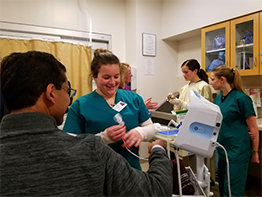
Do you not know what health profession to choose? There are many options available, including anesthesiologist and physician. Hopefully you have gained some insight from this article. We also provide actionable steps to help you get the job you want. To help you choose the career path you want, ask yourself some questions. If you are passionate about helping people, you might want to consider a career in healthcare.
Anesthesiologist
You might consider becoming an anesthesiologist if you are looking for a high-paying job in high demand. This occupation is highly respected and has solid prospects for advancement and upward mobility. American citizens work until their 60s. Anesthesiologists are a rewarding career that offers a great work-life balance. Anesthesiologists' career prospects are excellent if they enjoy a fast-paced work environment with a high degree of autonomy and a balanced lifestyle.
The education required for becoming an anesthesiologist begins in high school. This health career is for students who are interested in advanced science and have the opportunity to work in a medical facility. The typical four-year residency program for anesthesiologists is completed after students graduate. Anesthesiologists could focus on pain medicine and critical care or education.
Assistant in occupational therapy
With the increasing number of baby boomers, occupational therapy assistants are in high demand. This occupation is growing at an even faster rate than average. Between 2018 and 2024, the projected growth in these professionals will be 29%. Occupational therapy assistants need to have at minimum an associate's in order to obtain certification. To be an occupational therapy assistant you will need to complete a certificate course and then obtain a license.

Occupational therapy assistants are trained in the anatomy of people and how to interact with them. They also take courses in healthcare industry management, as well as professional best practices. They will have a greater knowledge base and a better understanding of clinical reasoning. The benefits to becoming an OTA are evident. Millions of people can benefit from occupational therapy assistants. There are many rewarding careers for an Occupational therapy assistant (OTA).
Paramedic
Paramedics offer many advantages to those who are thinking about a career. The job is very low-stress and offers great prospects for advancement. It also allows you to have a happy work-life-balance. You can also earn an additional income by working as a paramedic/EMT while you are in school. Here are some benefits to becoming a paramedic/EMT. They include: The ability to work under pressure and the ability to be calm under pressure. This type of experience is very valuable in medical school admissions. EMTs can also prepare to take the MCAT.
Paramedic training is similar to other health career options. It requires an associate's degree. Paramedical training programs are offered by most community colleges and universities. They require approximately 200-400 hours of study. Students who graduate with a certificate in cardiopulmonary resuscitation will be certified. Some programs require additional coursework like medication administration, drug abuse, and behavioral crises. Depending on where you go to school, paramedic training can take up to two or three years to complete.
Physician
An impressive education is a prerequisite for a physician who wants to be a part of specialized health care careers. A growing population is looking for health care professionals to help them live longer and be in good physical condition. New technologies in healthcare are also expanding options. There are many paths to becoming a physician. These are some of the options.

As the highest-paid members of the health care profession, physicians and surgeons earn a very good salary. On average, doctors earn $167,000 annually. Although salaries are subject to variation, physicians typically earn more than nurses practitioners and other primary-care providers. Physicians are among the most highly-paid professions in America. They also enjoy a high standard of living. In addition to their high salaries, physicians also have the advantage of working with diverse patients.
FAQ
What can be done to increase your immune system's effectiveness?
There are trillions upon trillions on cells in the human body. These cells combine to form organs or tissues that serve specific functions. A cell that dies will be replaced by another. Cells communicate with one another using chemical signals called hormonal hormones. Hormones regulate all bodily processes, from growth and development to metabolism and immunity.
Hormones, chemicals that are secreted throughout the body by glands, are chemicals. They travel through the blood stream and act like messengers to control how our bodies function. Some hormones are made internally, while others are created outside the body.
The hormone-producing glands release their contents into bloodstream. This is when hormone production starts. Once hormones are released they move through the bloodstream until they reach their intended organ. Some hormones may only remain active for a limited time. Others hormones are more active and have a longer life expectancy. They can still influence the body's functions long after they are eliminated from the bloodstream.
Some hormones can be produced in large amounts. Others are only produced in very small quantities.
Some hormones are produced at certain times during life. Estrogen is one example. It's produced in puberty, pregnancy and menopause. Estrogen aids women in developing breasts, maintaining bone density and preventing osteoporosis. It also promotes hair growth and keeps skin smooth and soft.
What is the difference between sugar and fat?
Fat is an energy source that comes from food. Sugar is naturally found in fruits and veggies. Both fats as well as sugars contain the same amount of calories. But, fats have more calories than sugars.
Fats can be stored in the body, which can lead to obesity. They can lead to cholesterol buildup in the arteries, which could cause heart attacks or strokes.
Sugars are quickly absorbed into the body and provide instant fuel. This causes blood glucose levels to rise. High blood glucose levels are dangerous as it can increase the likelihood of developing type 2 diabetes.
How much should my body weight be for my height? BMI calculator and chart
Calculating your body mass index (BMI), is the best method to calculate how much weight to lose. The healthy BMI range for a healthy person is 18.5 to 24.9. If you want to lose weight, then you should aim to drop about 10 pounds per month. Enter your height in the BMI calculator.
To see if you're overweight or obese, check out this BMI chart.
Statistics
- WHO recommends reducing saturated fats to less than 10% of total energy intake; reducing trans-fats to less than 1% of total energy intake; and replacing both saturated fats and trans-fats to unsaturated fats. (who.int)
- Extra virgin olive oil may benefit heart health, as people who consume it have a lower risk for dying from heart attacks and strokes according to some evidence (57Trusted Source (healthline.com)
- According to the 2020 Dietary Guidelines for Americans, a balanced diet high in fruits and vegetables, lean protein, low-fat dairy and whole grains is needed for optimal energy. (mayoclinichealthsystem.org)
- This article received 11 testimonials and 86% of readers who voted found it helpful, earning it our reader-approved status. (wikihow.com)
External Links
How To
What does the meaning of "vitamin?"
Vitamins are organic compounds found naturally in food. Vitamins are essential for our bodies to absorb nutrients from the foods we eat. Vitamins cannot be made by the body; they must be taken from food.
Two types of vitamins exist: water-soluble vitamin and fat-soluble vitamin. Water-soluble vitamins dissolve easily when they are dissolved in water. Examples include vitamin C,B1 (thiamine), B2 (riboflavin), B3 (niacin), B6 (pyridoxine), folic acid, biotin, pantothenic acid, and choline. The liver and fatty tissues are home to fat-soluble vitamins. Vitamin D, E, K and A are some examples.
Vitamins can be classified according to biological activity. There are eight major groups of vitamins:
-
A - Vital for normal growth and maintaining good health.
-
C - important for proper nerve function and energy production.
-
D - essential for healthy bones, teeth, and gums.
-
E is necessary for good vision, reproduction.
-
K – Required for healthy nerves & muscles.
-
P – vital for building strong bones.
-
Q - Aids digestion and iron absorption
-
R - Red blood cells are made from red blood cells.
The recommended daily allowance of vitamins (RDA), varies according to age, gender, physical condition, and other factors. The U.S. Food and Drug Administration (FDA) sets the RDA values.
For adults aged 19 and older, the RDA for vitamin B is 400 micrograms daily. Pregnant women require 600 micrograms daily to support fetal development. Children ages 1-8 require 900 micrograms per day. For infants younger than one year, 700 micrograms are required daily. However, this number drops to 500 micrograms each day for children aged 9-12 months.
Children aged 1-18 years need 800 micrograms daily, while children overweight require 1000 micrograms per days. Children who are severely obese or underweight will need 1200 micrograms each day.
Children ages 4-8 years who have been diagnosed with anemia need 2200 micrograms per day of vitamin C.
2000 micrograms are required daily for good health in adults over 50. Due to their increased nutrient needs, pregnant and breastfeeding women need 3000 micrograms daily.
Adults over 70 need 1500 micrograms daily, as they lose 10% of their muscle every ten years.
Women who are pregnant and lactating need more nutrients than the RDA. Pregnant women need 4000 micrograms per dayduring pregnancy and 2500 micrograms per day after delivery. Breastfeeding mothers need to consume 5000 micrograms every day when breastmilk has been produced.